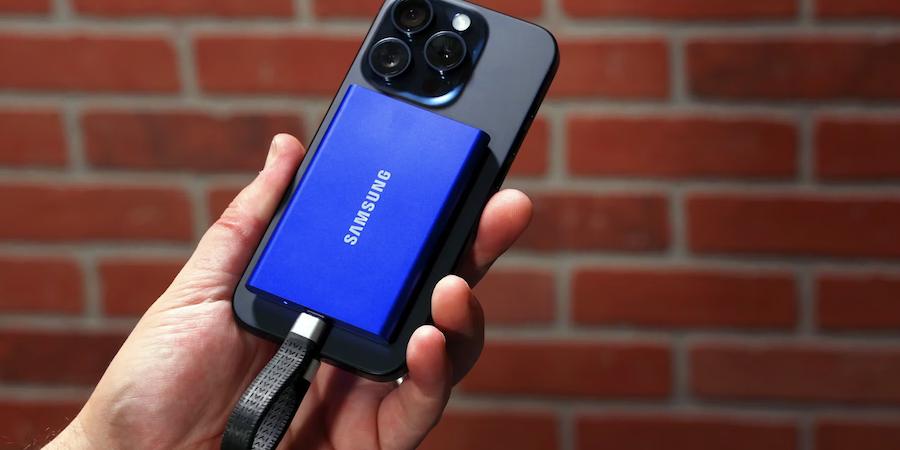Creative professionals who need to shoot high-quality video content have many reasons to like the new iPhone 15 Pro and 15 Pro Max. For the first time, they can record ProRes 4K video at 60 frames per second (FPS).
And in another first, iPhone users can record ProRes videos directly onto an external drive, such as a portable SSD, thanks to Apple’s adoption of the USB Type-C port. If you’re recording ProRes 4K 60 FPS videos, an external, portable storage device is required.
Apple, which previously used its proprietary Lightning connector, is supporting USB Type-C in its iPhone 15s to comply with European Union regulations. EU lawmakers have forced manufacturers to use USB Type-C, also called USB-C, as a universal charging port for technology to cut down on unnecessary charger purchases and reduce e-waste.
As a result, users can easily connect their iPhone 15 Pro phones to USB-C external storage, such as the Samsung Portable SSD T7 and Samsung Portable SSD T9, for video recording and data transfers.
What is ProRes video recording, why is it important and who uses it?
Raw, uncompressed video takes up a lot of storage. But video codecs like ProRes, H.264 and H.265, compress video into smaller files, making it easier to store and distribute video.
ProRes, developed by Apple in 2007, uses less compression than the more common H.264 and H.265 codecs. The result is videos with better image quality and less color deterioration, while enabling faster encoding and decoding, according to CNET. ProRes was first introduced on Apple’s phones with the release of the iPhone 13 Pro and 13 Pro Max models in 2021.
Though compression on ProRes does result in some lost image detail, it’s not visually noticeable, according to ZDNet. Videographers and filmmakers have embraced ProRes because it produces video with “amazing detail and color depth.” They can process the video files and color grade them for the look they want without sacrificing quality, while the compression keeps the file sizes more manageable.
Maximize video capture with external storage
ProRes does produce stunning video, but the size of the video can be up to 30 times larger than H.265 files, according to Apple. Giant video files can eat up iPhone storage fast. For example, a 20-second video recorded in ProRes (4K/60 FPS) takes up almost 2GB of storage.
Get your complete guide to SSD management
Discover how to effectively adopt and manage SSDs in your organization with this ultimate guide. Download Now
As a result, Apple has strict requirements if video content creators want to use their iPhones to record in ProRes (4K/60 FPS). They need an iPhone 15 Pro or 15 Pro Max with a portable, external storage device attached. And to record directly onto their phones, users need at least 10% of their iPhone storage to be free.
Here’s where the new iPhone’s USB-C support makes a difference. Instead of filling up their phone storage, users can record in ProRes (4K/60 FPS) directly onto a USB-C external drive, such as a portable SSD.
In fact, singer Olivia Rodrigo’s recent music video was shot on an iPhone 15 Pro and recorded in ProRes using an external USB-C drive.
To do so, external USB-C drives must support speeds of at least 220 MB/s with a maximum power draw of 4.5W. Not every external drive is compatible, so it’s critical for users to deploy external drives that support those requirements.
Super-fast storage with Samsung Portable SSDs
Three Samsung Portable USB-C SSDs — T7, T7 Shield and T9 — offer the ideal solution for on-the-go, creative professionals who need to record in ProRes.
Samsung’s Portable SSD T7 — available in 500GB, 1TB and 2TB — reaches sequential read/write speeds of 1,050/1,000 MB/s, which is twice as fast as the T5 model. Plus, it can withstand a 6.5-foot drop.
T7 Shield, which can store up to 4TB, offers the same read/write speeds as the T7 but is more rugged, water and dust-resistant, and can handle a nearly 10-foot drop.
The newest model, Samsung Portable SSD T9 — available in 1TB, 2TB and 4TB models — features sequential read/write speeds of 2,000 MB/s and can also withstand a nearly 10-foot drop.
After recording video, creative professionals can quickly transfer their ProRes video files from a portable SSD onto their desktop or laptop computers so they can edit their videos. In fact, T9 can transfer a 2GB file in seconds.
Samsung testing shows that these three Samsung Portable SSDs can be used by iPhone 15 Pro and 15 Pro Max users for ProRes video recording without any compatibility issues or performance drops.
What are the other benefits of external mobile storage?
Besides recording video, creators with any iPhone 15 can use their portable SSDs to quickly back up photos and other files from their phones instead of using cloud storage or computer hard drives, which can fill up quickly.
Samsung’s Portable SSDs offer blazing-fast transfer speeds. For example, T7 and T7 Shield support the USB 3.2 Gen 2 interface, which offers 10Gbps transfer rates. Meanwhile, T9 supports the USB 3.2 Gen 2×2 interface, which features two 10Gbps lanes for 20Gbps of throughput.
These Portable SSDs also bolster data security by supporting AES 256-bit hardware encryption.
As Apple’s switch to USB-C enables iPhone 15 Pro and 15 Pro Max users to record breathtaking, high-quality videos using ProRes directly on external drives, it’s the Samsung Portable SSD T7, T7 Shield and T9 that provide them the perfect solution to bring their creative vision to life.
Not sure which SSD is the right solution for you? Browse Samsung’s acclaimed SSD offerings for the right size and form factor for your needs.
ProRes video capture made possible with Samsung Portable SSDs - Insights by Samsung
Read More



No comments:
Post a Comment